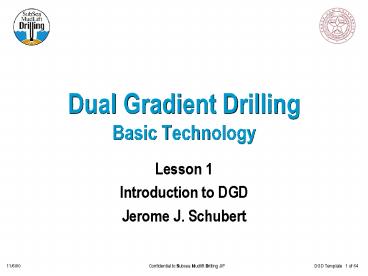Dual Gradient Drilling Basic Technology - PowerPoint PPT Presentation
1 / 40
Title:
Dual Gradient Drilling Basic Technology
Description:
Dual Gradient Drilling Basic Technology Lesson 1 Introduction to DGD Jerome J. Schubert Introduction Current deepwater drilling problems Introduction, con t Brief ... – PowerPoint PPT presentation
Number of Views:541
Avg rating:3.0/5.0
Title: Dual Gradient Drilling Basic Technology
1
Dual Gradient Drilling Basic Technology
- Lesson 1
- Introduction to DGD
- Jerome J. Schubert
2
Introduction
- Current deepwater drilling problems
3
Introduction, cont
- Brief history of DGD
- Phase I
- Phase II
- Phase III
4
Introduction, cont
- Describe the DGD System
- How can DGD can solve the existing drilling
problems? - Equipment overview
5
Current Deepwater Drilling Problems
- Deeper water results in longer and heavier
drilling risers - High pore pressures and low fracture gradients
leads to more casing strings
6
Land Well
2 strings of casing after 20
7
500 Water Depth
2 strings of casing after 20
8
1000 Water Depth
2 strings of casing after 20
9
5000 Water Depth
3 strings of casing after 20
10
10,000 Water Depth
4 strings of casing after 20 with no kick or
trip margins
11
0.5 ppg Standoff
6 strings of casing after 20
12
Current Deepwater Drilling Problems
- Too many shallow casing points
- May not reach TD
- No contingency casing available
- This leads to larger wellheads, even larger and
heavier risers, and finally to bigger and more
expensive rigs
13
Current Deepwater Drilling Problems
- Well Control is more difficult - because of the
pore pressure/fracture proximity, and long choke
lines with high friction pressure drops
14
Kick w/ 750 psi SIP
Mud HSP (13.1 ppg) Mud HSP 750 psi
Formation has fractured
Pore Pressure Fracture Pressure
15
Current Deepwater Drilling Problems
- Very high riser loads (current and weight)
- Weight of the drilling riser increases with depth.
16
Current Deepwater Drilling Problems
- In 10,000 of water
- 21-inch riser has an internal capacity of 4000
bbls! (1 million) - Weight of the riser itself is 2million lbs
- Weight of 16 ppg mud inside the riser 2.7
million lbs
17
Current Deepwater Drilling Problems
- Water depths beyond rig fleet
- New builds and major upgrades
18
Current Deepwater Drilling Problems
- Small wellbore at TD precludes large production
tubing - limiting production rates - Began 2nd quarter of 2000
19
Drillings Major Benefits of DGD
- Reduces drilling cost by 5-15 MM per well in
young depositional basins (4 casing strings) - Provides contingency casing for SWFs, sub-salt
20
Drillings Major Benefits of DGD
- Allows room for high rate completions
- Expands capacity of existing rig fleet
- Mitigates effects of high currents
- Improves Well Control margin
21
Describe the DGD System
- DGD Drilling, in the present context, refers to
drilling where mud returns DO NOT go through a
conventional, large-diameter, drilling riser. - Instead the returns move from the seafloor to
the surface through one or more small - diameter
pipe(s) separate from the drillpipe. - A Mudlift system is used in the Return Line
- A Dual Gradient mud system is achieved.
22
Single vs. Dual Gradient Concept
- Single Gradient Wells
- Wellbore contains a single density fluid
- Single pressure gradient
- Dual Gradient Well
- Wellbore feels seawater gradient to the seafloor,
and mud gradient to bottom
Pressure, psi
Depth ft
Seafloor _at_ 10,000
23,880 psi _at_ 37,500
23
Dual Gradient Achieved by
- Placing SRD on top of the BOP stack and diverting
the mud flow from the annulus to the MLP - The MLP then pumps mud back to the rig via the
return lines - Suction pressure to the MLP is maintained at
Seawater HSP 20 to 50 psi
24
Single vs. Dual-Gradient Mud Systems
From the perspective of the well, there is no mud
above the mudline in a dual-gradient system!
Figure 3
25
How can DGD can solve the existing drilling
problems?
- By placing the MLP on the seafloor we can reduce
the pressure exerted on the shallow weak
formations and still maintain the required
pressure at the bottom of the hole to control
formation pressure - Riser margin is back - emergency disconnect and
drive-off will not result in an automatic kick.
26
Pore and Fracture Gradients
27
Graphical Casing Seat Selection - Dual Density
28
Dynamic Casing Seat Selection
Pressure, psi
D e p t h ft.
1.0 ppg kick 0 bbl influx volume
Frac. Press.
Pore Press.
29
Dynamic Casing Seat Selection
Frac. Press.
1.0 ppg kick 50 bbl influx volume
Pore Press.
30
Kick Tolerance is Back
Conventional
DGD
20 _at_ 12,500 16 _at_ 13,000 13 3/8 _at_
14,000 11 3/4 _at_ 15,000 9 5/8 _at_ 17,500 7
5/8 _at_20,000 5 1/2 _at_ TD
0.5 ppg standoff no influx
20 _at_ 12,500
16 _at_ 14,000
1.0 ppg kick, 50 bbl influx
13 3/8 _at_ 17,000 11 3/4 _at_ 22,800 9 5/8 _at_ TD
31
Equipment overview
- Marine Riser
- SRD - SubSea Rotating Diverter
- DSV - Drillstring Valve
- MLP - MudLift Pump
- Return Lines
- Manifolding
- Dual Trip Tanks
32
SubSea MudLift Configuration
Mud Return and Pump
Return Line
Drillpipe
Seawater Filled Marine Riser
Rotating Diverter
Seawater-Driven MudLift Pump
Wellhead and BOP
BHA
Drill String Valve
33
Marine Riser
- Essentially a conventional riser filled with
seawater
34
Wellbore Components
Riser Adapter
Subsea Rotating Diverter (SRD)
35
Drill String Valve (DSV)
Flow Nozzle
Closing Spring
36
Seawater Driven MudLift Pump
37
Diaphragm Pump
Stroke Indicator Sensor (Fixed)
Stroke Indicator Magnet Assembly
Hydraulic Fluid In/Out
Stroke Indicator Tube (Moving)
Connection to Diaphragm
Diaphragm
Mud In/Out
38
Seawater Driven MudLift System
14 x 17 x 11h 175,000 lbs plus Seawater Conduit
ROV-Style Cables
Mud
B
C
K
H
Seawater
39
Return LinesManifoldingSeawater Trip TankMud
Trip Tank
40
The End
- Jerome J. Schubert
- Introduction to DGD































